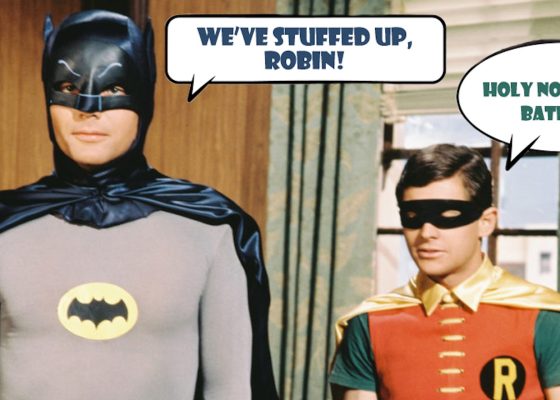It’s there, it’s just being kicked from pillar to post by fear of the cost of the NDIS. What brought us to this?
Nobody, federally at least, wants to talk about the National Health Reform Agreement.
I’m writing this before yesterday’s Health Ministers meeting, so everything may have changed overnight, but the chances of that seem slim, at best.
The states do want to talk about the NHRA because they feel putting public pressure on the federal government is the best way of getting what they want – more money from the Commonwealth for their shiny hospitals, and less of that Big Scary Expensive Thing nobody wants – responsibility for the NDIS.
But nobody at a federal level – be it the Department, or the ministers, or anyone else involved in the NHRA negotiations – wants to talk about it.
Not even at a recent large summit of top-level bureaucrats, academics, economists and, yes, Chatham House rules-compliant journalists like me, did anyone talk about the current NHRA and the negotiations.
Not even during a 20-minute presentation which focused on the 2011 NHRA, and how the negotiations and politics around that set the system up for the situation we now find ourselves in, was the current NHRA and the negotiations mentioned.
I learned a lot from that presentation. And, given that I’m not going to mention where or when the summit was, nor who gave the presentation, I think I can safely tell you what I learned.
The original NHRA came into being in 2011, when Julia Gillard was prime minister, although it was her victim – sorry, predecessor – Kevin Rudd, who was the chief architect.
It was a big year.
The National Health Performance Authority was established under the NHRA Act 2011 as an independent body to provide “locally relevant and nationally consistent information” on the performance of healthcare organisations and health systems.
The Australian National Preventive Health Agency was set up to provide “national capacity to drive preventive health policies and programs, and to strengthen Australia’s investment and infrastructure in preventive health”.
Someone at the aforementioned summit described the 2011 NHRA as “not only a key piece of health system design, but a key piece of market design”.
They sound like good ideas, don’t they? Both bodies came in to being through legislation so that the normal to and fro of Commonwealth-state relations couldn’t just wipe them out in the next NHRA.
Sadly, nobody counted on Tony Abbott’s prime ministership.
The ANPHA ceased operations on 30 June 2014, its key functions were transferred to the Department of Health and, despite the Australian National Preventive Health Agency (Abolition) Bill 2014 being voted down in the Senate, nobody’s managed to get it up and running again since.
The NHPA ceased operations on 30 June 2016 and the agency’s performance reporting functions transferred to the Australian Institute of Health and Welfare from 1 July 2016.
Could it be that health reforms have not progressed as far as we might have anticipated since 2011 precisely because those two pieces of “key health system and market design” were canned?
Before the 2011 NHRA, hospital funding was tied up through five-year agreements called Australian Health Care Agreements. AHCAs fixed the Commonwealth contribution for five years, so if costs went up over the subsequent years, the states carried the risk.
The contribution varied from state to state, depending on political muscle and media influence. For example, in 2005, WA only got a 27% contribution from the feds, while another state got 51% and another got 42%.
Apart from anything else, that led to a lot of rationing, usually through waiting lists for elective surgery, a lack of transparency about how that money translated into care and the priorities for care, and a fiscal imbalance.
Mr Rudd’s 2011 NHRA changed all that. It reflected the Medicare principles of free public hospitals with access based on clinical need, not ability to pay. It established and clarified roles for the various institutions involved in paying and delivering hospital care, and local hospital networks.
Related
It enshrined states as the system managers who would oversee and coordinate those local hospital networks and gave them skin in the game through shared funding arrangements.
It also established independent pricing, price setting such that the Commonwealth contribution to hospital funding was based on the national average cost of hospital services.
The reason for the independent pricing authority – now known as IHACPA – was simple. The states and territories didn’t trust the Commonwealth, and the Commonwealth didn’t trust the states and territories.
Importantly, the 2011 NHRA established incentives to increase activity through activity-based funding.
ABF improved technical efficiency by establishing a National Efficient Price to ensure hospitals were compensated for higher-cost patients through a classification system.
The other nifty things in that original NHRA but have been forgotten in the mists of time, were requirements for states to develop consumer and clinical engagement structures, targeted priorities around emergency access and elective surgery, and a very strong focus on safety and quality.
There are two problems with the above system.
One is that the NEP follows the costs that can be observed in the data. If those costs are not obvious in the data, they will not inform the price. That’s a problem for under-serviced populations who do gain timely access to care that may not be fully reflected in the data.
The second problem is that there are clear incentives for innovations that improve technical efficiency. There are fewer incentives for allocative efficiency and to introduce models of care that improve outcomes at higher costs.
So where are we now?
We have a healthcare system acknowledged as one of the best in the world. Yet it feels like we’re death-riding that reputation without doing much to make sure it stays that way in the face of choked emergency departments, increasing bed block, the coming apocalypse of ageing Boomers and Gen-Xers, spiralling chronic disease, and a teetering private hospital sector.
As someone at the summit said:
“If you’re getting bad results, it’s because of the design of the system. It’s not because of evil actors. If you want different results, it’s axiomatic you have to change the system.
“The 2011 NHRA was a success because that new pricing regime was implemented alongside whole new funding and delivery architectures. If financial administrative systems aren’t redesigned to complement the desired different outcome, the results can be weird, which is often missed in social and political debate.”
Here’s an example of exactly that. The recent Productivity Commission report, Delivering quality care more efficiently, recommended collaborative commissioning as one of its four big pillars of reform.
In Tasmania, they actually have legislation that forbids a form of collaborative commissioning called alliance contracting, that prevents collaboration and fund-sharing. So good luck implementing a national CC framework there.
As that anonymous person at the secret summit said:
“It’s not going to be effective unless there are governance and pricing models to support it from the top, and there are delivery structures and mechanisms to receive it from the bottom.”
What’s my point in all this?
We need urgent reform 2011-style that will re-embed prevention, data collection and sharing to enable an accurate and responsive NEP, a hospital funding model that is fit for purpose, and structures at top and bottom that can implement reforms.
But until the federal government stops using hospital funding and the NDIS as a club to beat the states with, and the states start recognising that shiny new hospitals are not the be all and end all of keeping their voters healthy, we’re going to get nowhere.
I never thought I would say this, but where’s Kevin Rudd when you need him?




